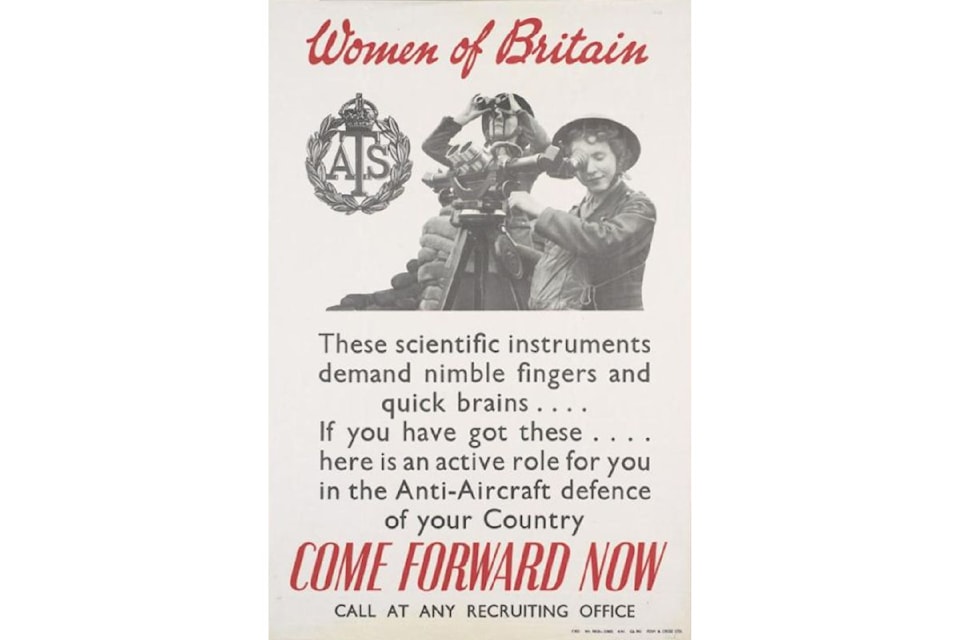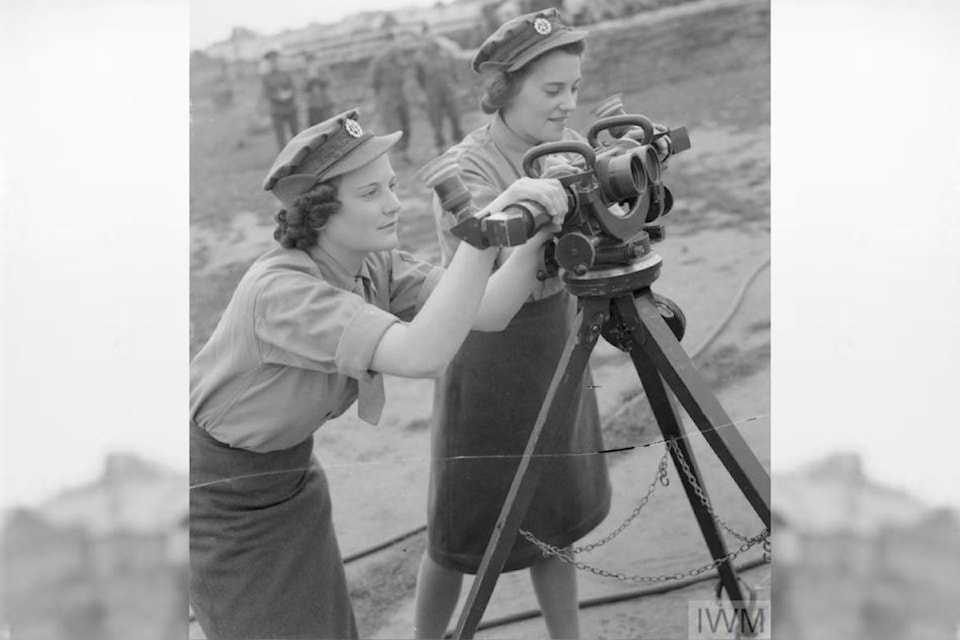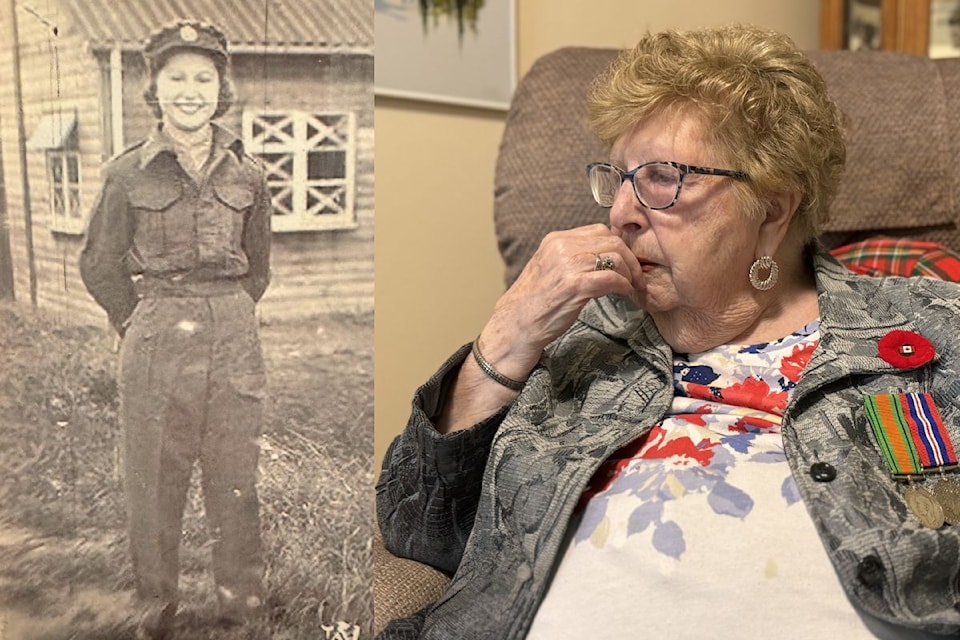The synopsis of a book by English author Sylvia Broady, published in February of this year reads:
“Determined to do her bit for the war effort, Yorkshire lass Evie Sinclair leaves her island home to become an Ack Ack Gunner Girl, defending Britain from Luftwaffe attacks.”
Except for the island home, Lily Bales, now a Sidney resident, could very well be the protagonist in the book “The Gunner Girls– Evie's Story.”
Lily’s story is one of courage.
In April 1941, a new kind of job opened for the women of the Auxiliary Territorial Service (ATS), the women’s branch of the British Army during the Second World War. Her Royal Highness Princess Elizabeth was a member of the ATS.
The job required women to show great aptitude, great reflexes and natural courage.
Each of them had to be tested and assessed before they made the cut to become Gunner Girls a.k.a. Ack Ack Girls, the nickname given to women who manned the anti-aircraft guns.
Lily, who lived on Rayners Lane in the London suburb of Harrow, enlisted to become one of them.
“At 17, the war was not going well overseas and at home. London was devastated. Our street was bombed and people were sleeping down in the tube train stations. At this point, I told my parents that I wanted to join the forces. Of course, they were not enthused as my brother was already serving. I argued that if it was good enough for the royals, it was good enough for me.”
She was under-aged, shy and unassuming when she joined the army but it was something that she truly wanted to do at that time.

The Ack Ack girls
Soon, as Gunner Lily Wallace, she was sent for basic training for the ATS as a gun layer, which was, in fact, “radar” in its infancy. She was part of the mixed men and women heavy anti-aircraft battery attached to the Royal Artillery (RA).
“I knew Robert Alexander Watson-Watt (inventor of radar) was up there somewhere because we often heard his name mentioned.”
The “Ack Ack” unit was manned by a “spotter” who would use binoculars to find enemy planes and two “height-and-range finders” who used a large piece of equipment to calculate the distance a shell would have to travel to hit the target. A “predictor” worked out where the plane would be and the time it would take a shell to reach it to shoot down the plane, all in a matter of seconds.
Lily was a spotter working in shifts of six hours a day, in a set that had a diesel generator for power, a transmitter to send out radio waves and a receiver.
To get the duty team into action, two girls ran down to the generator to crank the big handle, rotating it several times until enough momentum was reached to bang down the governor-locking bar.
“Sometimes, if one was not careful, it was possible to catch your hand on the metal clip, a painful experience.”
Once locked in, the transmitter is activated. The receiver, positioned in a field far away, consisted of a box made of fibreboard, about 10’ x 12’ x 7’ high and moved 360 degrees when manned.

The terrifying dash
Lily recalls the receiver was elevated on top of a mat of chicken wire much larger than a football field to receive the signal of approaching aircraft.
Four women were required to man it in action but to access it, a skinny gangplank was built over the netting, sometimes several feet from the ground.
“We were alone out there with no other protection than our steel helmets. I must convey how terrifying this “dash” was on a moonless night when one’s legs have turned to jelly, and the boom of distant guns signals approaching aircraft.”
Together with her unit, they kept their equipment in perfect condition, performing daily, weekly and monthly tests and adjustments, including cleaning the antennae of the transmitter which were metal poles placed at right angles across a perpendicular ladder.
“They were 10 inches higher than the roof and the rungs were 18 inches apart making it hard to climb. One had to stretch out as far as possible to clean the poles. It was a scary job and I never volunteered unless ordered.”
Life was noisy and difficult at their gun site because of the heavy 4.5-inch ammunition that was used. After heavy rains, the muddy ground made it difficult for them to reach their equipment, so they had to make paths by loading barrows of rubble from bombed buildings.
“It was bullish hard work, and the men recognized us for our efforts."
The life of a gun layer was anything but predictable. While the duties remained the same, their sleeping quarters did not.
“One time when the Luftwaffe was flying over Britain, we were rushed to the south coast in the middle of the night to a farmer’s field with fresh cut stubble about six inches high. We were given small tents to pitch and a huge tent was erected for meals."
"The first few days on the field, water was sparse until it arrived by truck," Lily remembers vividly. “Nowhere to wash our delightful khaki bloomers, but some of the girls found a stream close by and excitedly rushed to do their washing only to find it was covered in scum."
Amid the frenzy of war, Lily calls her time with the girls the best part of being an Ack Ack girl.
Maybe, second best.
During her time at the battery, she met her husband, Melvin Bales, who was with the Canadian Air Force stationed in the U.K. doing maintenance work on the Wellington Bombers. At 20, Lily and Melvin got married and moved to Canada after the war.
Remembering the friendship she formed with the Ack Ack Girls at 17 has profoundly changed her. At 100 years old, she proudly wears her medals to honour all the girls she worked alongside and those who contributed to the war effort in their own way.

